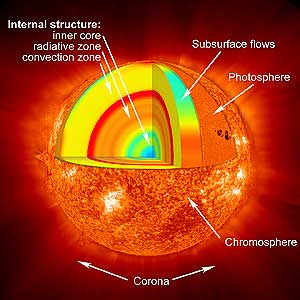Jam Band Friday – http://www.youtube.com/watch?v=KIYiGA_rIls
You would think that we would take advantage of that.
http://nineplanets.org/sol.html
Sol
The New Solar System
Summarizes what we’ve learned from interplanetary explorations in the last 25 years. My primary reference for The Nine Planets.
The Compact NASA Atlas of the Solar System
This ‘road map’ of the solar system is the definitive guide for planetary science.
Our Sun is a normal main-sequence G2 star, one of more than 100 billion stars in our galaxy.
diameter: 1,390,000 km. mass: 1.989e30 kg temperature: 5800 K (surface) 15,600,000 K (core)
The Sun is by far the largest object in the solar system. It contains more than 99.8% of the total mass of the Solar System (Jupiter contains most of the rest).
It is often said that the Sun is an “ordinary” star. That’s true in the sense that there are many others similar to it. But there are many more smaller stars than larger ones; the Sun is in the top 10% by mass. The median size of stars in our galaxy is probably less than half the mass of the Sun.
The Sun is personified in many mythologies: the Greeks called it Helios and the Romans called it Sol.
The Sun is, at present, about 70% hydrogen and 28% helium by mass everything else (“metals“) amounts to less than 2%. This changes slowly over time as the Sun converts hydrogen to helium in its core.
The outer layers of the Sun exhibit differential rotation: at the equator the surface rotates once every 25.4 days; near the poles it’s as much as 36 days. This odd behavior is due to the fact that the Sun is not a solid body like the Earth. Similar effects are seen in the gas planets. The differential rotation extends considerably down into the interior of the Sun but the core of the Sun rotates as a solid body.
Conditions at the Sun’s core (approximately the inner 25% of its radius) are extreme. The temperature is 15.6 million Kelvin and the pressure is 250 billion atmospheres. At the center of the core the Sun’s density is more than 150 times that of water.
:}
http://www.youtube.com/watch?v=qiSkyEyBczU
:}
In fact hard as it is to believe…Jupiter and the Sun constitute 95% of the matter in the solar system..We be pretty small.
http://www.solarviews.com/eng/sun.htm
The Sun is the most prominent feature in our solar system. It is the largest object and contains approximately 98% of the total solar system mass. One hundred and nine Earths would be required to fit across the Sun’s disk, and its interior could hold over 1.3 million Earths. The Sun’s outer visible layer is called the photosphere and has a temperature of 6,000°C (11,000°F). This layer has a mottled appearance due to the turbulent eruptions of energy at the surface.
Solar energy is created deep within the core of the Sun. It is here that the temperature (15,000,000° C; 27,000,000° F) and pressure (340 billion times Earth’s air pressure at sea level) is so intense that nuclear reactions take place. This reaction causes four protons or hydrogen nuclei to fuse together to form one alpha particle or helium nucleus. The alpha particle is about .7 percent less massive than the four protons. The difference in mass is expelled as energy and is carried to the surface of the Sun, through a process known as convection, where it is released as light and heat. Energy generated in the Sun’s core takes a million years to reach its surface. Every second 700 million tons of hydrogen are converted into helium ashes. In the process 5 million tons of pure energy is released; therefore, as time goes on the Sun is becoming lighter.
The chromosphere is above the photosphere. Solar energy passes through this region on its way out from the center of the Sun. Faculae and flares arise in the chromosphere. Faculae are bright luminous hydrogen clouds which form above regions where sunspots are about to form. Flares are bright filaments of hot gas emerging from sunspot regions. Sunspots are dark depressions on the photosphere with a typical temperature of 4,000°C (7,000°F).
The corona is the outer part of the Sun’s atmosphere. It is in this region that prominences appears. Prominences are immense clouds of glowing gas that erupt from the upper chromosphere. The outer region of the corona stretches far into space and consists of particles traveling slowly away from the Sun. The corona can only be seen during total solar eclipses.
The Sun appears to have been active for 4.6 billion years and has enough fuel to go on for another five billion years or so. At the end of its life, the Sun will start to fuse helium into heavier elements and begin to swell up, ultimately growing so large that it will swallow the Earth. After a billion years as a red giant, it will suddenly collapse into a white dwarf — the final end product of a star like ours. It may take a trillion years to cool off completely
:}
http://www.youtube.com/watch?v=gmDWvGKLzBE
:}
According to the world’s leading experts, also known as Rocket Scientists.
http://www.nasa.gov/worldbook/sun_worldbook.html
Electromagnetic radiation
Electromagnetic radiation consists of electrical and magnetic energy. The radiation can be thought of as waves of energy or as particle-like “packets” of energy called photons.
Visible light, infrared rays, and other forms of electromagnetic radiation differ in their energy. Six bands of energy span the entire spectrum (range) of electromagnetic energy. From the least energetic to the most energetic, they are: radio waves, infrared rays, visible light, ultraviolet rays, X rays, and gamma rays. Microwaves, which are high-energy radio waves, are sometimes considered to be a separate band. The sun emits radiation of each type in the spectrum.
The amount of energy in electromagnetic waves is directly related to their wavelength, the distance between successive wave crests. The more energetic the radiation, the shorter the wavelength. For example, gamma rays have shorter wavelengths than radio waves. The energy in an individual photon is related to the position of the photon in the spectrum. For instance, a gamma ray photon has more energy than a photon of radio energy.
All forms of electromagnetic radiation travel through space at the same speed, commonly known as the speed of light: 186,282 miles (299,792 kilometers) per second. At this rate, a photon emitted by the sun takes only about 8 minutes to reach Earth.
The amount of electromagnetic radiation from the sun that reaches the top of Earth’s atmosphere is known as the solar constant. This amount is about 1,370 watts per square meter. But only about 40 percent of the energy in this radiation reaches Earth’s surface. The atmosphere blocks some of the visible and infrared radiation, almost all the ultraviolet rays, and all the X rays and gamma rays. But nearly all the radio energy reaches Earth’s surface.
Particle radiation
Protons and electrons flow continually outward from the sun in all directions as the solar wind. These particles come close to Earth, but Earth’s magnetic field prevents them from reaching the surface.
However, more intense concentrations of particles from flares and coronal mass ejections on the sun reach Earth’s atmosphere. These particles are known as solar cosmic rays. Most of them are protons, but they also include heavier nuclei as well as electrons. They are extremely energetic. As a result, they can be hazardous to astronauts in orbit or to orbiting satellites.
The cosmic rays cannot reach Earth’s surface. When they collide with atoms at the top of the atmosphere, they change into a shower of less energetic particles. But, because the solar events are so energetic, they can create geomagnetic storms, major disturbances in Earth’s magnetic field. The storms, in turn, can disrupt electrical equipment on Earth’s surface. For example, they can overload power lines, leading to blackouts.
:}
Monday – Let’s all live in caves.
You knew I’d have to play it, right?
http://www.youtube.com/watch?v=U6tV11acSRk
:}


